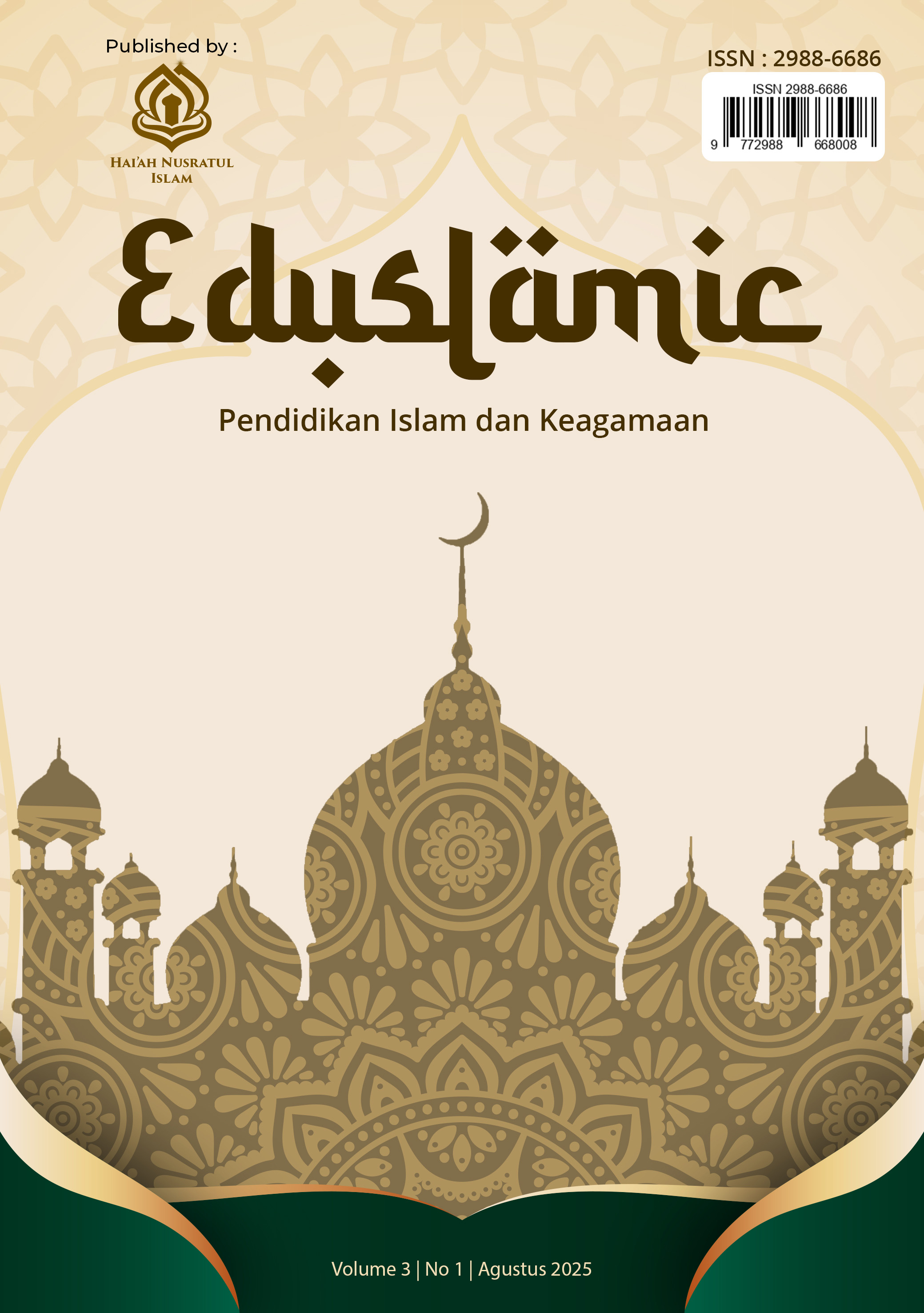MORPHOLOGICAL ANALYSIS OF FI‘IL MUJARRAD AND FI‘IL MAZĪD BI ḤARFIN IN SURAH AL-KAHFI
DOI:
https://doi.org/10.59548/jed.v3i1.385Keywords:
Morphology, Fi’il Mujarrad, Fi’il Mazīd, Surah Al-KahfiAbstract
This study aims to analyze the forms of verbs in Surah Al-Kahfi Ayat 9–26, especially in the story of Ashḥābul Kahfi, through a morphological approach (ṣarf) using a qualitative literature study method. The main focus of the study is to classify and study in depth the verbs of tsulāthī mujarrad and mazīd bi ḥarfin, and to explain their functions and meaning tendencies in the context of the Ayat. In the analysis process, each verb is reviewed in terms of madī and muḍāri‘ forms, wazan patterns, basic or additional meanings, and their relationship to the meaning of the Ayat as a whole. The results of the study show that the verbs of tsulāthī mujarrad tend to be used to describe the direct actions of the young men of Ashḥābul Kahfi, such as talking, walking, or sleeping. Meanwhile, the verbs of mazīd bi ḥarfin appear more often in the context of Allah's intervention or power, such as giving instructions, revealing events, or recording information. This finding reveals how the choice of the form of the fi’il in the Qur’an has a significant semantic and rhetorical role, and shows the richness of the structure and economy of the Arabic language. This analysis is expected to broaden scientific insight in the field of Qur’anic linguistics and contribute to Arabic morphological studies, especially in understanding the structure of fi’il derived from the sacred text.
References
Amrulloh, M. A., & Himmah, R. H. (2017). Analisis Perubahan Morfologis Pembentukan Ta’rib dan Pembelajaran. Tadris: Jurnal Keguruan dan Ilmu Tarbiyah, 2(2), 87–96. https://doi.org/10.24042/tadris.v2i2.2064
Defnaldi, D. (2022). Afiksasi Morfologi Pada Fi’il Tsulaasi Maziid Geminasi Dalam Bahasa Arab. Ar-Rusyd: Jurnal Pendidikan Agama Islam, 1(2), 121–136. https://doi.org/10.61094/arrusyd.2830-2281.50
Fidiyawati, A., & Akbar, D. W. (2022). Syntactic Analysis of Qowaid Harfu Maa in the Qur’an Surah Al-Kahfi. 11.
Ghofur, M. A., Fadholi, A., & Tauhid, M. H. (2024). Analisis Morfologi Fi’il Madhi Dan Fi’il Mudhori Pada Ayat Al-Qur’an Surat An-Naba Juz 30. AS-SUNNIYYAH, 4(01), 32–38. https://doi.org/10.62097/assunniyyah.v4i01.1880
Hakim, M. L. (2020). PROSES MORFOLOGIS WAZAN-WAZAN FI’IL MAZID DAN
MAKNANYA DALAM AL-QURAN JUZ 28. Tarling : Journal of Language Education, 3(2), 201–228. https://doi.org/10.24090/tarling.v3i2.3532
Hakim, M. L., & Hanafi, Y. (2023). Proses Morfologis Wazan-Wazan Fi’il Mazid dan Maknanya dalam Al-Quran Juz 28.
Hasanah, L., & Sofa, A. R. (2022). Penerapan Morfologi Bahasa Arab dalam Bahasa Indonesia: Studi Kasus di MI Nidhamiyah Ketompen Pajarakan.
Kasir, M. (2024). Aptana: Jurnal Ilmu & Humaniora ISSN3026-281X. 02(01).
Khasanah, S. N., & Baehaqie, I. (2020). Penanda Makna Jamak Bahasa Indonesia dan Bahasa Arab Pada Aspek Morfologis (Analisis Kontrastif). Jurnal Sastra Indonesia, 9(3), 172– 179. https://doi.org/10.15294/jsi.v9i3.39876
Lundeto, A. (2018). Analisis Metode Pengajaran Fonetik dan Morfologi Bahasa Arab. Jurnal Ilmiah Iqra’, 3(1). https://doi.org/10.30984/jii.v3i1.546
Downloads
Published
How to Cite
Issue
Section
License
Copyright (c) 2025 Lutfiana Sefira

This work is licensed under a Creative Commons Attribution 4.0 International License.
- Share — copy and redistribute the material in any medium or format for any purpose, even commercially.
- Adapt — remix, transform, and build upon the material for any purpose, even commercially.
- The licensor cannot revoke these freedoms as long as you follow the license terms.
Under the following terms:
- Attribution — You must give appropriate credit , provide a link to the license, and indicate if changes were made . You may do so in any reasonable manner, but not in any way that suggests the licensor endorses you or your use.
- No additional restrictions — You may not apply legal terms or technological measures that legally restrict others from doing anything the license permits.
Notices:
You do not have to comply with the license for elements of the material in the public domain or where your use is permitted by an applicable exception or limitation .
No warranties are given. The license may not give you all of the permissions necessary for your intended use. For example, other rights such as publicity, privacy, or moral rights may limit how you use the material.












 Eduslamic: Jurnal Pendidikan Islam dan Keagamaan by
Eduslamic: Jurnal Pendidikan Islam dan Keagamaan by 
